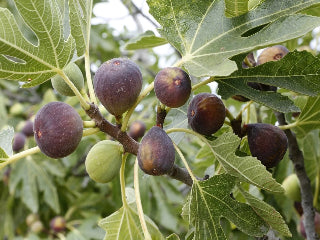
Scientific Name: Ficus carica belonging to the Moraceae family
Origin: Mediterranean region and Asia
Description: The fig tree is a small to medium sized tree or shrub with a thin gray bark. It has large, rough, green leaves with three to five lobes. The fruits form on new branches and appear in a teardrop shape in a wide range of colors, from dark colors such as brown or purple to light such as yellow or green. Figs are considered inverted flowers as the flowers form inside the fruit cavity (Abhinav, et. al, 2024).
Historical Medicinal Use: Madame Fouquet offers a remedy for gout sciatica which is prepared by turning mustard seeds and figs into a paste so it can be casted over the affected area.
Modern Medicinal Use: Figs contain considerable amounts of fiber and antioxidants as well as several minerals including potassium, calcium and magnesium. They can be used to boost the immune system and regulate the digestive system (Pacchioli, 2023).
Abhinav , Vivek, et. al, “Fig.” Encyclopædia Britannica, Encyclopædia Britannica, inc., 8 Mar. 2024, www.britannica.com/plant/fig#:~:text=A%20Quiz-,Physical%20description,a%20white%20latex%20when%20broken.
Pacchioli, Lila. “Discover the Benefits of the Fig Tree.” NATURVEDA Plants and Health , Laboratoire NATURVEDA , 24 Nov. 2023, naturveda.fr/en/blogs/actus-sante/discover-the-benefits-of-fig-tree.
Shoemaker, SaVanna. “Figs: Nutrition, Benefits, and Downsides.” Healthline, Healthline Media, 3 June 2020, www.healthline.com/nutrition/figs-benefits#nutrition.
De Fouquet, Marie. Recueil des remèdes faciles et domestiques, choisis et expérimentés, et très approuvés pour toutes sortes de maladies internes et externes, et difficiles à guerir. 1685.